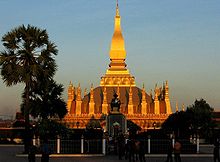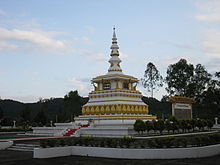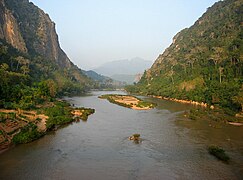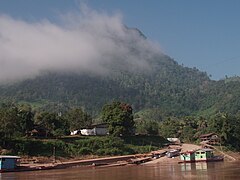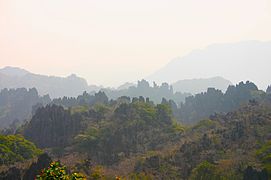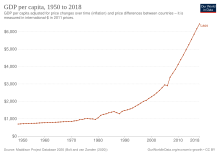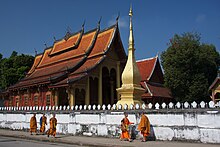Laos
laos , officially popular democratic republic Lao sovereign situated on the Indochina peninsula and the only landlocked country in Southeast Asia. It is bordered by Burma and China to the northwest, Vietnam to the east, Cambodia to the southeast, and Thailand to the west and southwest. Its capital and most populous city is Vientiane. It has an area of 236,800 km² and an estimated population in 2016 of 6,758,353 inhabitants.
The current territory of Laos belonged to the kingdom of Lan Xang («Land of a Million Elephants») between the 14th and 18th centuries. After a period of internal conflict, Lan Xang was divided into three kingdoms, Luang Prabang, Vientiane, and Champasak. In 1893, they came under a French protectorate and united to form present-day Laos. The country briefly became independent in 1945 after the Japanese occupation, but was recolonized by France until its independence in 1953, with a constitutional monarchy headed by Sisavang Vong. Between 1954 and 1975 the country went through a civil war, which saw communist groups backed by the Soviet Union fight against the monarchy which later fell under the influence of US-backed military regimes. The war culminated in the rise to power of the communists of the Pathet Lao. Currently, the country is a one-party socialist republic that espouses Marxism-Leninism, although market-oriented reforms have been passed since the mid-1980s.
The country has a wide ethnic variety, but 53.2% belong to the Lao ethnic group. The term "Lao" is also used to refer to the dominant and official language of the country, although French is also spoken. The people of Laos are Mon-Khmer groups, the Hmong and other native tribes living mainly in the foothills and mountains of the country. Laos is classified as one of the countries with the lowest degree of economic freedom (see Lao economy in this regard). In 2003, 80% of the economically active population was engaged in subsistence farming, however it has been one of the fastest growing economies in Southeast Asia and the Pacific, with an average annual GDP growth of 7.4 % since 2009. It is a member of ASEAN, the East Asia Summit, La Francophonie and the World Trade Organization.
Etymology
The name of the country in the Lao language is Muang Lao (ເມືອງລາວ). It was the French, when Laos was part of French Indochina, who added an "s" to the name.[citation needed] The form Lao is sometimes used in English to also refer to the country, but romanization standards usually hold that "Laos&# 3. 4; it is the correct form in that language.[citation needed] As for Spanish, the traditional form of the name of this country is Laos, and Lao should not be used as a short name.
History
Remnants of Laotian history date back to the kingdom of Lan Xang, founded in the 14th century, which lasted until the 18th century, when Siam invaded and took over the remaining separate principalities. To avoid a costly war with the French, the King of Siam ceded to them the lands now known as Laos, and these were incorporated into French Indochina in 1893.
Following a brief Japanese occupation during World War II, the country declared its independence in 1945, but the French reasserted their control and only in 1950 did Laos gain semi-autonomy as an "associated state" within the French Union. In addition, the French continued to be in de facto control until 1954, when Laos gained full independence as a constitutional monarchy. Under a special exemption from the Geneva Convention, the French training army continued to support the Royal Lao Army.
In 1955, the US Department of Defense created a special office for program evaluation to replace French support of the Royal Laotian Army against the communist Pathet Lao as part of US containment policy.
Political tensions in neighboring Vietnam dragged Laos into the Second Indochina War, a destabilizing factor that contributed to the Laotian Civil War and several coups. The North Vietnamese Army invaded and occupied portions of eastern Laos. The North Vietnamese Army, with its powerful weapons including heavy artillery and tanks, was the real power behind the Pathet Lao insurgency. Significant aerial bombardments by the United States followed one another with the intention of this country to eliminate North Vietnamese bases in Laos and to interrupt the supply lines on the Ho Chi Minh Trail. The United States intervened in a hidden way through Operation White Star.
The U.S. waged the Vietnam War and wanted to cut Laos' supply paths to its Vietnamese enemy and prevent the country from taking sides for communism. The way to achieve this is one of the most unknown and brutal war crimes ever committed: U.S. aircraft carried out more than 584 000 missions and dropped more than 260 million cluster bombs on the most populous areas of the country (an average ton of explosives per inhabitant). The American pilots themselves would admit years after they never tried to distinguish between civilians and soldiers. 'If anything moved, we bombed it.'
The war took place between 1964 and 1973: "Not a single building remains from before the US bombing, the mountains look like gruyere cheeses because of the number of holes left by the B-52s and the population has invented all a culture of taking advantage of the legacy of war: bombs are used to build barbed wire fences, kitchen utensils, water tanks or that prosthesis that allows poor peasants to walk."
In 1968 the Pathet Lao (communist) and North Vietnamese Army launched a multi-division attack on the Royal Lao Army. The attack resulted in the extensive demobilization of the army and the leaving of the conflict to irregular forces assembled by the United States and Thailand. In 1974 a new government coalition was formed where only supporters of Suvana Fuma and Pathet Lao participated. But in 1975, before the fall of Saigon, Pathet Lao gained more strength, forcing the monarchists to go into exile in France. The civil war killed between 20,000 and 62,000 Laotians in total.
In 1975 the communist Pathet Lao, backed by the Soviet Union and the North Vietnamese army, overthrew the monarchical government, forcing King Savang Vatthana to abdicate on December 2, 1975 (he later died in prison).
After taking control of the country, they renamed it the Lao Democratic Republic. The Pathet Lao government subsequently signed agreements giving Vietnam the right to commit military forces and appoint advisers to help oversee the country. Then the Pathet Lao was able to found the Lao People's Republic, abolishing the monarchy. However, Vietnamese troops did not withdraw until 1990.
Family groups that managed to maintain internal cohesion as an economic group are now undergoing their "healthy" in the second generation, diversifying the radius of insertion in various activities, but maintaining its base in agricultural work that supports the whole.
On April 6, 1994, the Friendship Bridge was inaugurated over the Mekong River, uniting Laos and Thailand and sealing the reconciliation between the two peoples. Coincidentally, the withdrawal from Vietnam began, beginning a new integration, this time with Thailand and Burma.
In the late 1970s Vietnam ordered Laos to end relations with China, this cut off trade with any country except Vietnam [citation needed]. Control by Vietnam and socialization were slowly replaced by a relaxation of economic restrictions in the 1980s and admission to ASEAN in 1997. Vietnam continues to exert political and economic influence in Laos. The twenty-year embargo by the United States was lifted in 1995. The United States established normal trade relations with Laos in November 2004.
Government and politics
Government
Although the Lao People's Republic was proclaimed in 1975, it was not until 1991 that the first constitution was promulgated, which confirmed the political monopoly of the Lao People's Revolutionary Party, of a communist nature and the only legal one,[ citation needed] while endorsing private property and a free market economy.[citation needed]
- Executive branch. Under the constitution of 1991 a president, elected by the National Assembly of Laos for a period of five years, exercised the executive power. The Prime Minister assists the President, who chairs the Council of Ministers, who performs the administrative functions of the government.
- Legislative authority. The legislature resides in the National Assembly of Laos. Its members are elected by universal suffrage for a period of five years.
- Judiciary. The Supreme Court of Laos is the highest judicial body responsible for non-administrative matters by popular courts.
Human Rights
In terms of human rights, regarding membership of the seven bodies of the International Bill of Human Rights, which include the Human Rights Committee (HRC), Laos has signed or ratified:
Anti-personnel mines that were dropped en masse by the US Air Force continued to cause heavy casualties long after the end of the war. With a non-explosion rate of 20% to 30% on impact, they remained scattered over most of the country, claiming between several hundred and twenty thousand victims a year, with a fatality rate of around 50%. Several countries provided assistance to the Lao PDR, including the establishment of the Mine Consultative Group. (MAG), based in the UK. However, the British press notes that the United States refused to disclose to MAG the 'deactivation instructions and procedures', still classified as a defense secret in the early 2000s.
Territorial organization
Laos is divided into 17 provinces (kang), one prefecture and one municipality (nakon del kumpang). In turn, the provinces and the prefecture are divided into districts (muang) and villages (baan). The capital is located in Vientiane Prefecture, which in turn is located in the province of the same name. The current territorial organization is as follows:
- Attapu Province
- Bokeo Province
- Province of Bolikhamxai
- Province of Champasak
- Houaphan Province
- Khammouan Province
- Luang Namtha Province
- Luang Prabang Province
- Oudomxai Province
- Phongsali Province
- Sainyabuli Province
- Province of Salavan
- Savannakhet Province
- Sekong Province
- Vientiane Prefecture
- Vientiane Province
- Xiangkhoang Province
Geography
Laos is a landlocked state in Southeast Asia and the heavily forested landscape consists mostly of rugged mountains, the highest of which is Phou Bia at 2,820 meters, with some plains and plateaus.
The Mekong River forms a part of the western border with Thailand, while the mountains of the Annamite Range form most of the eastern border with Vietnam.
The local climate is tropical and characterized by monsoons; there is a rainy season from May to November, followed by a dry season from December to April.
About 65% of the surface is covered by dense vegetation typical of subtropical forests. The capital and the largest city of Laos is Vientiane. Also important are Luang Prabang, Savannakhet and Pakse.
Environment
Laos had 125,610 km² of forests, which represented 54.4% of the national territory (in the year 2000).[citation required] The country counts with a good system of protected areas that cover 20% of the national territory. The fauna abounds in tigers, leopards, buffaloes and elephants; the latter are used as pack animals.
This vast biodiversity is threatened by a flourishing illegal trade: Laos is the only country in the region that has not signed the CITES agreement banning such trade. In addition, a large part of the country's forests are empty of life, because the rural population hunted with traps and ate almost all the large animals that existed, with the exception of some muntiacus.
Not only illegal trade threatens wildlife, deforestation and soil erosion have led to the disappearance of green areas. 0.41% of the forests were lost between 1990 and 2000; high population growth, logging for commercial purposes (trees for latex or rubber production replace native forests), and slashing and burning of forests contributed to this deforestation. This trend has not abated in recent years, as the majority of the population depends on slash-and-burn agriculture for survival. In addition, 80% of the country's energy consumption comes from firewood and coal. The high rates of deforestation have caused an increase in erosion, with its consequences for soils and sources of drinking water.
Climate
The climate is tropical, but there are large variations in temperature between different areas, mainly due to altitude. The main features of the climate are determined by the monsoons. The wet summer season lasts from May to October, with average rainfall of 1,788 mm, and a cool season that runs from November to February; the rest of the year is hot and humid. In the capital of the country, in April (the warmest month of the year) temperatures reach an average of 28.9 °C, while in January they are 21.7 °C.
Natural resources
Laos has a large forest area. Its jungles are home to highly valuable woods, mainly teak. These jungles have various species of animals that are used by rural inhabitants, however the largest deer and mummy have been exterminated.
The country has scarce mineral resources, but it has good tin reserves. It also has great potential for hydroelectric power. Throughout the country there are large tracts of fertile soil suitable for agriculture, however there are many eroded or eroding soils. The main areas with fertile soils are found in the Mekong River valleys and on the Bolaven Plateau. The waters of the Mekong irrigate vast tracts of rice crops and provide abundant fishing, one of the country's basic food sources.
Economy
The socialist political and economic organization of Laos began decentralizing control and encouraging national enterprise in 1986. Starting from a very low base, the results were astounding.
Laos opened up to "new economic mechanisms" in 1986. The Investment Code was promulgated in the wake in 1988. It opens the economy to foreign participation and promotes the notions of profit, profitability and productivity. Since then, private enterprise has been considered the center of the "new economic management system". In 1989, a first Structural Adjustment Program was adopted with the support of the IMF and the World Bank. Since 2009, the United States has recognized Laos as a country that respects the market economy. Thanks to this recognition, American companies that invest in the country can receive public aid.
Growth averaged 7% over the period 1988-2001, except for a short time, due to the 1997 Asian financial crisis.
Despite this high growth rate, Laos is a country with a primitive infrastructure, having no railways, a rudimentary road system, and limited external and internal telecommunications.[citation needed] Electricity is not available in many rural areas.
Subsistence agriculture accounts for half of GDP and provides 80% of total employment. The economy is aided by the International Monetary Fund, other international sources, and new foreign investment in the food processing and mining sectors.
Laotian farmers fear producing and cultivating their land due to the number of active antipersonnel mines coming from the United States. Of 4,000,000, only 1% have been deactivated.[citation needed]
Agriculture
Agriculture is the country's main economic activity. Rice is the main food-oriented crop, the annual harvest in 2006 was 2,660,000 t, which, however, was not enough to cover national needs.
Other important crops are fruit (210,615 t, among which are pineapple and citrus fruits), corn (210,000 t), tapioca (66,000 t) and potatoes (36,000 t).
Livestock
Livestock also play an important economic role. In 2005 the livestock herd had 1,827,000 head of pigs, 1,272,000 cattle and 1,000,000 water buffaloes, as well as 24,300,000 poultry, oxen, horses and elephants.[citation required]
Tourism
In recent years, the number of tourists has grown. This is because the effects of the Vietnam War are less apparent today. This is not to say that there are no effects yet. There are many options for exploring Laos and this country offers something different for everyone who visits it.
The tourism sector has grown rapidly, from 80,000 international visitors in 1990, to 1.876 million in 2010. Tourism is expected to contribute US$679.1 million to the gross national product in 2010, expected to reach to US$1.5857 million in 2020. In 2010, one in 10.9 jobs was in the tourism sector. Receipts from international visitors and tourism goods are expected to generate 15.5 percent of total exports or US$270.3 million in 2010, growing in nominal terms to US$484.2 million (12.5 percent of the total) in 2020.
The official tourism motto is " simply beautiful". The main attractions for tourists include the Buddhist culture and colonial architecture in Luang Prabang; gastronomy and ancient temples in the capital Vientiane; backpacking in Muang Ngoi Neua and Vang Vieng; ancient and modern culture and history in the region of the 'Páramo de las tinajas'; The history of the Lao Civil War at Xam Neua; trekking and visiting hill tribes in some areas, including Phongsaly and Luang Namtha; tiger and wildlife viewing at Nam Et-Phou Louey; caves and waterfalls near Thakhek; relaxation, the Irawadi river dolphin and the Khone Phapheng Falls in Si Phan Don or the fluvial archipelago of 4000 islands; Vat Phou, an ancient temple complex of the Khmer Empire; and the Bolaven Plateau for its waterfalls and coffee. The European Council for Trade and Tourism awarded the country the designation "Best Tourist Destination in the World" in 2013 for its combination of architecture and history.
Luang Prabang and Vat Phou are World Heritage Sites, the Plain of Jars hopes to join them once unexploded ordnance cleanup is complete. Major festivities include Laotian New Year which is celebrated around April 13-15 and consists of a water festival, but more subdued than in Thailand and other Southeast Asian countries.
The Lao National Tourism Administration, related government agencies and the private sector are working together to realize the vision outlined in the country's National Ecotourism Strategy and Action Plan. This includes reducing the environmental and cultural impact of tourism; increasing awareness of the importance of ethnic groups and biological diversity; providing a source of income to conserve, maintain and manage the Lao network protected area and cultural heritage sites and emphasizing the need for zoning and tourism management plans for sites that will be developed as ecotourism destinations.
Demographics
Laos has a population of 6,677,534 (2008) which means a density of 29 inhab/km². About a quarter of the population lives in the mountainous regions, the rest along the Mekong River and its tributaries. More than 78% live in rural villages. There are Laotian communities abroad, with France, the United States and Australia being their main destinations. There is also a Laotian community in the French overseas territory of French Guiana.
69% of the country's population belongs to the Lao ethnic group, as well as being the main inhabitants of the lowlands and the politically and culturally dominant group. The Laos belong to the Tai language group that began migrating south from China in the first millennium AD. A further 8% belong to other 'lowland' groups, who together with the Lao people make up the Lao Lum.
Hill people and Laotian cultural minorities such as the Hmong (Miao), Yao, Tai Dumm, Dao, Shan, and various Tibeto-Burmese groups have lived in isolated regions of Laos for many years. Hill tribes of mixed ethnocultural heritage are found in northern Laos and include the Lua and Jamu, who are indigenous to Laos. Currently, the lua group is considered endangered. Collectively, they are known as lao sung or highland Laotian. The central and southern highlands are dominated by the Mon Khmer tribes, known as the Lao Theung or Midland Laotian. Some Vietnamese and Chinese minorities remain, particularly in the cities, but many left in two great migrations: after independence in the late 1940s and again after 1975.
The term "Laotian" it does not necessarily refer to the ethnic Lao language, the Lao people or their customs, but is a political term that also includes non-ethnic Lao groups within Laos and identifies them as "Laotian" for their political citizenship. Similarly the word "lao" It can also describe the people, cuisine, language, and culture of the people of Northeast Thailand (Isan), North Thailand (Chiang Mai), and Chiang Rai who are ethnically Lao.
The official and dominant language is Lao, a tonal language of the Tai language group. Midland and highland Laotians speak a variety of tribal languages. French, still common in government and commerce, being studied by many as a second language, while English, the language of the Association of Southeast Asian Nations (ASEAN), has become increasingly studied in recent years. years.
The overall average height of the native population in Laos is 155.9 centimeters, making it one of the countries with the shortest overall average height in the world.
Main cities
The capital Vientiane has a population of 720,000 (2005). The former royal capital Luang Prabang with 68,000 inhabitants. Other cities are Savannajét (97,000 inhabitants) and Pakxé (47,000 inhabitants), which is located on the Mekong River.
Education
Laos is a mostly rural country, many towns have little accessibility to this right. Bearing in mind that the country has gone through tumultuous times, education has been left unprotected, along with it the economic and social sector.
Currently UNICEF together with the local government continue to promote, among other goals, the development and growth of education, facilitating access to good quality education, developing corresponding infrastructures to provide education. This cycle will promote the participation of families and communities in the school education of children.
In 2000 there were 828,113 students in primary schools and about 124,000 students in secondary schools. The total number of enrollments in teacher training colleges and higher education of 28,117 students.
Culture
Religion
The predominant religion is Theravāda Buddhism which, along with the common animism practiced among hill tribes, coexists with spiritual worship. There are also small numbers of Christians, largely restricted to the Vientiane area, and Muslims, especially in the Burmese border region.
Gastronomy
As food is the trademark of every corner of the planet, it is interesting to get to know the Laotian palate. The "bread" Khao niaú (glutinous rice) is a must on the table. It is an accompaniment to dishes such as: tam mak hung (papaya salad), mok (thick locro of bamboo and pork, wrapped in banana leaves), lap... (beef salad /lap cín/, fish /lap pa/, prawns /lap kung/), cín lot (fried meat bites) or ping kai (roasted chicken), are dishes with characteristic aromas.
With respect to sweet dishes, khau niaú is present, accompanied by coconut milk, sugar, fruit, and ingenuity resulting in desserts such as: khau sankañaa (rice prepared with coconut accompanied by: bites mango or coconut flan), khau niaú kap mak thua dam (rice with black beans), mak kuai thoght (fried bananas), khau tóm (rice and peanut snacks), luom mix (coconut milk with fruits).
Holidays
| Date | Name in Spanish | Local name |
|---|---|---|
| 1 January | New Year | Pi mai |
| 6 January | National Day | Van Pathet Lao |
| 20 January | Army Day | Van Pathet Lao |
| From 14 to 16 April | Celebration New Year (according to Buddhist calendar) | Van Pi mai |
Sports
Laos' Olympic teams have not won any medals, nor has their national soccer team won any title.[citation needed] The Laotian Football Federation was founded in 1951, joined FIFA in 1952 and has been a member of the Asian Football Confederation since 1980. Notable players include Visay Phaphouvanin, Lamnao Singto and Kita Sysavanh.
Contenido relacionado
John kerry
Zapatista
Konosu (Saitama)
